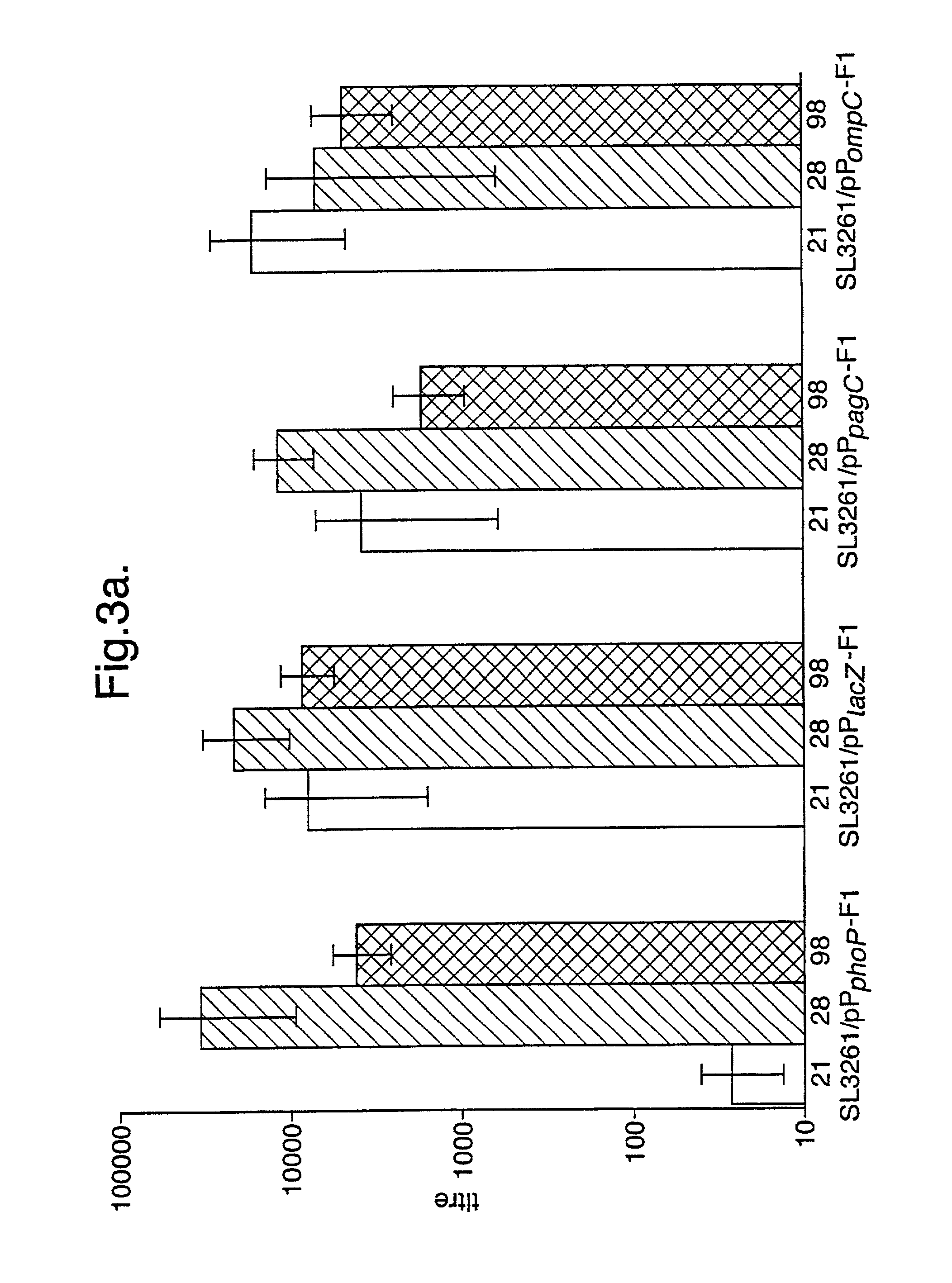Recombinant microorganisms
a technology of recombinant microorganisms and microorganisms, which is applied in the field of recombinant microorganisms, can solve the problems of reducing the immune response, unable to find suitable animal models for testing these vaccines, and promoters that are not suited to the expression of all guest antigens, so as to achieve the effect of enhancing the expression of a desired protein
- Summary
- Abstract
- Description
- Claims
- Application Information
AI Technical Summary
Benefits of technology
Problems solved by technology
Method used
Image
Examples
example 1
Preparation of Bacterial Strains, Cultivation and Enzymes
[0051]Escherichia coli strain JM109 and S. typhimurium strains LB5010 (rm*galE), SL3261 (aroA) or SL1344 (a mouse-virulent strain; (Zhang X, et al., Infect. Immun. 1997;65:5381-7) were cultured on L-agar or in L-broth, supplemented with ampicillin (05 μg / ml) where appropriate. Enzymes used for DNA cloning and amplification procedures were obtained from BCL limited (Lewes, Sussex, UK). PCR reactions were carried out using a Perkin Elmer 9600 (P.E. Applied Biosystems, Warrington, UK) thermal cycler with cycle conditions of 95° C., 5 min, followed by 50 cycles of 95° C., 5 s; 45° C., 5 s; 72° C., 5 s, followed by 10 min at 72° C.
[0052]Plasmids containing promoters for expression of F1-antigen were then produced. The promoters for the phoP, pagC and ompC genes have previously been mapped and upstream regulatory regions identified (Soncini F C, et al., J. Bacteriol. 1995;177:4364-71, Pulkkinen W S, et al., J. Bacteriol. 1991;173:8...
example 2
[0061]The stability of the different plasmids encoding F1-antigen driven from different promoters in S. typhimurium SL3261 was determined after culture of the bacteria in L-broth for 24 hr (in vitro stability) and enumeration of bacteria which grew on L-agar or L-agar containing amplicillin (Sambrook J, Frtisch E F, Maniatis T. 1989. Molecular Cloning: A Laboratory Manual, 2nd ed. Cold Spring Harbor Laboratory press, New York). The results indicated that all of the plasmids were retained by at least 80% of the bacteria which had been cultured in vitro (pPompC-F1, 83%; pPphoP-F1, 100%; pPpagC-F1, 98%; pPlacZ-F1, 95%).
example 3
Colonisation of Host Tissues
[0062]The in vivo stability of plasmids was determined by inoculating groups of 10 female BALB / c mice orally with 109 cfu of bacteria in 100 μl of PBS, and enumerating bacteria isolated 11 days later from homogenised spleen tissue on L-agar or L-agar+ampicillin.
[0063]In the case of the PpagC-F1 construct and the S. typhimurium SL3261 control strain, bacteria were also cultured from mesenteric lymph nodes (10 / mouse) each homogenised in 2 ml of PBS or from homogenised liver tissue which were removed on 11 days after dosing. Bacteria were enumerated bacteria as described above.
[0064]With the exception of the bacteria containing the PpagC-F1 plasmid and the SL3261 control bacteria, ampicillin-resistant bacteria could be recovered from all of the spleens isolated from orally dosed mice. The in vivo stability of all of the plasmids within Salmonella was lower than the stability of the plasmids within Salmonella cultured in vitro.
[0065]Although mice were dosed ...
PUM
| Property | Measurement | Unit |
|---|---|---|
| Pharmaceutically acceptable | aaaaa | aaaaa |
| Immunogenicity | aaaaa | aaaaa |
Abstract
Description
Claims
Application Information
 Login to View More
Login to View More - R&D
- Intellectual Property
- Life Sciences
- Materials
- Tech Scout
- Unparalleled Data Quality
- Higher Quality Content
- 60% Fewer Hallucinations
Browse by: Latest US Patents, China's latest patents, Technical Efficacy Thesaurus, Application Domain, Technology Topic, Popular Technical Reports.
© 2025 PatSnap. All rights reserved.Legal|Privacy policy|Modern Slavery Act Transparency Statement|Sitemap|About US| Contact US: help@patsnap.com



